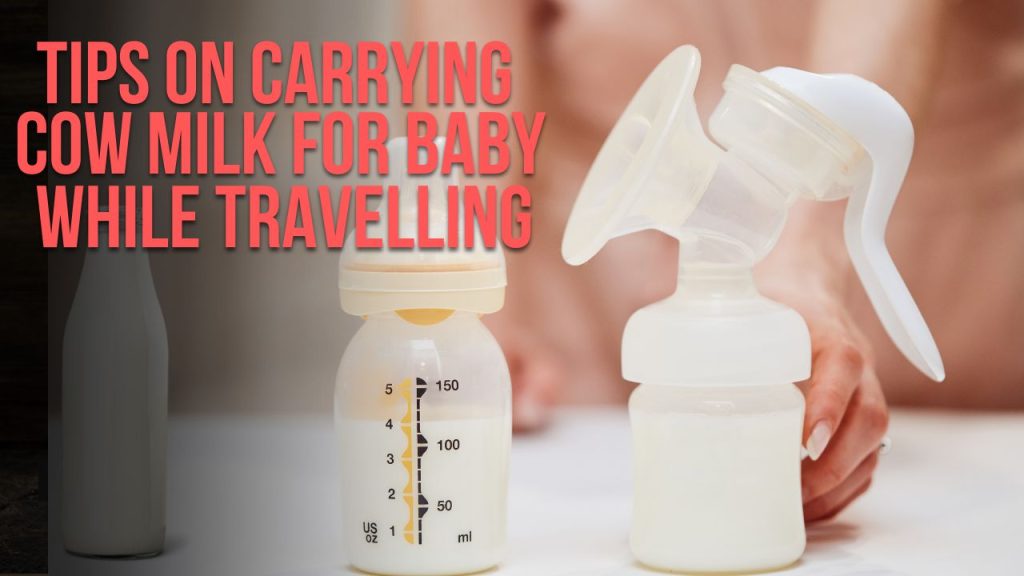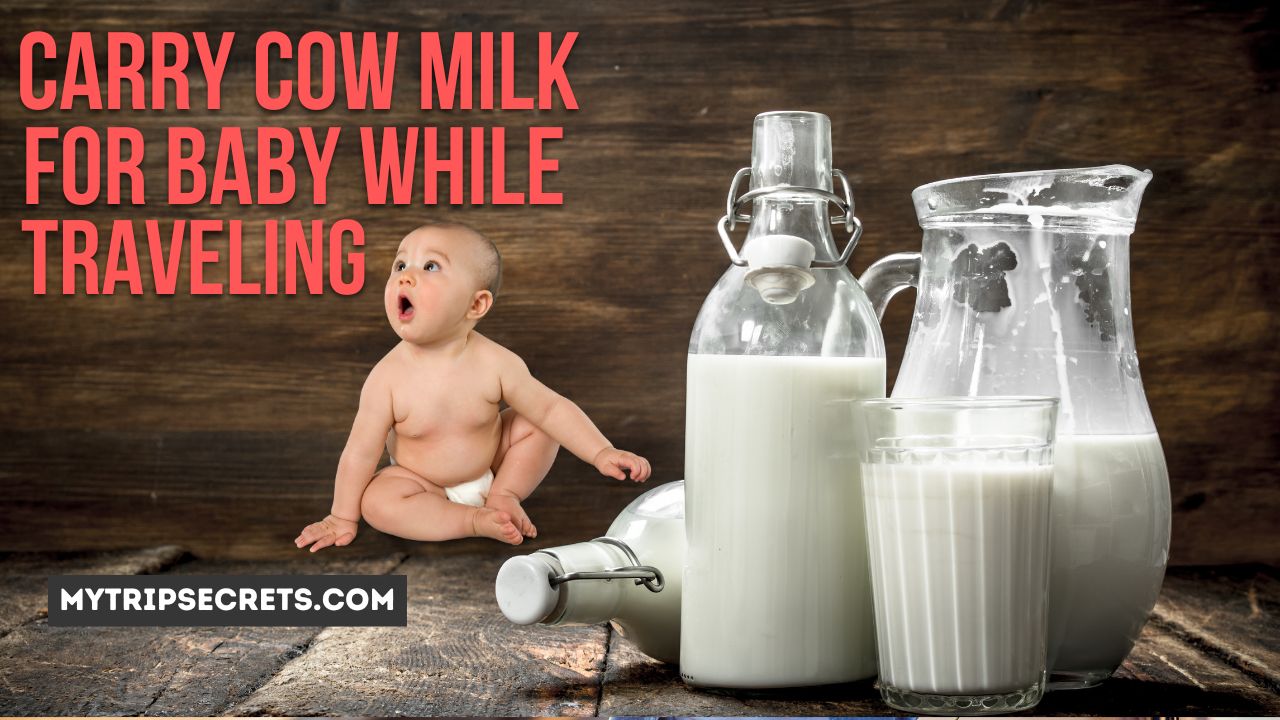Travelling with a baby can be challenging, especially when it comes to meeting their nutritional needs. As cow’s milk is an important part of a baby’s diet, knowing how to properly carry and store it while on the go is essential for any parent. This article will provide tips and considerations for carrying cow milk for your baby while travelling to ensure it remains safe and nutritious.
Contents
Carrying Cow Milk for Baby While Travelling
Cow’s milk provides babies with key nutrients like protein, calcium, vitamin D, and more for growth and development. The American Academy of Pediatrics recommends continuing breastfeeding or formula until 12 months, after which cow’s milk can become part of a baby’s diet. However, cow’s milk poses some transportation and storage challenges due to potential contamination and spoilage. Using proper techniques allows parents to include cow’s milk in a baby’s diet, even when travelling and on-the-go. This article outlines best practices for handling, carrying, and storing cow milk to meet your baby’s needs while maintaining safety and nutrition.
Choosing the Right Milk
When selecting cow’s milk for your baby while travelling, opt for ultra high-temperature pasteurized (UHT) milk. The UHT heating process creates a shelf-stable product that can be stored without refrigeration until opened. This allows UHT milk to be transported and carried easily without worry of spoilage. Standard pasteurized milk must remain refrigerated, making it difficult to take on-the-go. Popular UHT milk brands include Horizon Organic, Parmalat, and Natrel. These come in convenient single serving sizes that are perfect for travel.
Once open, UHT milk should be consumed within 2-3 hours if unrefrigerated, or within 5-7 days if refrigerated. When travelling, only open what your baby plans to consume to prevent waste and safety issues. If transporting already opened milk, follow refrigeration guidelines and ensure ample ice packs to keep cold as outlined later in this article. Only open new UHT milk as needed.
Safe Transportation Methods
When transporting cow milk for your baby on-the-go, the carrying method must keep the milk both secure and at a proper temperature. Here are some safe transportation options:
Insulated Bag/Cooler – The best option is carrying cow milk in an insulated bag or small cooler with ice packs. This maintains a cool temperature throughout the trip without risk of spills. Ensure there is sufficient ice to keep cold 4+ hours.
Thermos – A thermos can keep UHT milk securely cold for several hours, although carrying capacity is limited. Make sure to fill with cold milk and periodic temperature checks are recommended. Clean thoroughly between uses.
Cooler Packs – Individual cooler packs can be placed with single UHT milk boxes in a diaper bag or backpack to preserve freshness. Monitor temperature periodically for food safety.
In all cases, maintain diligence checking milk temperature and use within 2 hours if temperature exceeds 40° F. Do not refreeze thawed ice packs as this poses contamination risks. Ensure carriers remain clean and sanitized between uses following U.S. CDC guidelines.
At Destination Storage
Once reaching your destination while travelling with your baby, promptly store UHT milk boxes in the refrigerator. If carrying opened cow milk, either standard pasteurized from home or UHT opened en route, refrigeration is key to prevent spoilage. Here are refrigeration guidelines:
- Standard pasteurized milk: Consume within 5-7 days of opening
- UHT milk: Consume within 5-7 days once refrigerated after opening
If refrigeration is unavailable, UHT milk must be consumed within 2-3 hours after opening. Ice and cooler packs can assist short term periods without refrigeration if checked regularly. But for safety, periods without refrigeration should be minimized with opened cow milk.
Follow “Safe Transportation Methods” for carrying milk back home or to your next destination, and refrigerate immediately upon arrival if opened. Safety protocols are key both while travelling and at destinations when transporting cow milk for your baby.
Additional Safety Tips

Here are some additional safety considerations when carrying cow milk for babies while travelling:
- Wash hands thoroughly before handling milk boxes and bottles
- Sanitize equipment like bottles, nipples, caps before use
- Shake UHT milk gently before opening
- Inspect for signs of spoilage like odor, texture changes
- Discard any expired milk
- Never save unfinished bottles; discard after feeding
- Never refreeze thawed milk
Following food handling best practices minimizes safety issues when transporting cow milk. Remember the “two hour rule” – never leave dairy like cow milk sitting out past 2 hours, and discard if this occurs. Careful temperature control, washing hands and equipment that touches milk, checking expiration dates, and not reusing unfinished feedings reduces potential bacteria growth.
Developmental Considerations
As babies grow in age and developmental stages, needs change with regards to milk feedings on-the-go. Here is some age-based guidance:
- 0-6 months – Focus is breastmilk or formula. UHT cow milk not recommended yet but can transport small starter amounts.
- 6-12 months – Can introduce UHT cow milk alongside breastmilk/formula. Transport just a few feedings worth for trial.
- 1-2 years – Cow milk can become larger part of diet. Transport moderate amounts, offer other beverages too.
- 2+ years – Can carry larger quantities of cow milk as primary milk source. Prioritize adequate nutrition variety overall.
- Work closely with your pediatrician on the right developmental timeline for potentially introducing and expanding cow milk in your baby’s diet, especially when balancing other nutritional sources. Transport only amounts needed based on your baby’s current diet and introducing new beverages gradually. Focus on milk safety while also meeting total dietary diversity and requirements.
Frequently Asked Questions
Here are answers to some common questions when transporting cow milk for babies while traveling:
- How long can cow milk sit unrefrigerated?
Unopened UHT milk can sit 12 months shelf-stable. Once opened, UHT milk is safe only 2-3 hours unrefrigerated, while standard milk should not sit unrefrigerated.
- How do you store baby milk while traveling?
Use an insulated cooler bag and ice packs to maintain the temperature of pre-chilled milk or bottles at 36-40°F while traveling with infant formula. To facilitate direct feedings at a later time, a thermos can also be used to transfer smaller amounts. You can also use separate cooler packs in a diaper bag. Keep any unsealed containers of milk or formula refrigerated and use them within 24 hours after arrival.
- How do you carry milk in a long journey?
Store expressed breastmilk or formula in insulated cooler bags together with sufficient frozen gel packs to ensure temperature preservation. Restrict the frequency of accessing the cooler and consume its contents within 24 hours after defrosting. To travel small amounts of direct feeds, use thermoses filled immediately before departure. Store all milk under refrigeration at its destinations.
- Does cow milk need to stay cold like formula?
Yes. previously opened and standard pasteurized milk must remain refrigerated, like formula. New unopened UHT milk and individual servings are shelf-stable. Refrigerate all cow milk immediately if travelling over 2 hours.
- Can I reuse unfinished cow milk bottles?
No, for safety reasons leftovers or backwash can quickly contaminate reused bottles. Discard any unfinished feedings.
- Is it safe to transport cow milk across international borders?
Yes. but inspection protocols apply. Research importation laws on bovine products like milk when crossing international borders. Have supplemental formula available in case customs issues arise.
- Can I freeze transported UHT cow milk bottles?
No. UHT milk should not be frozen as it can compromise nutrition, taste and texture. Transport with ice packs only to preserve freshness en route.
Proper handling, carrying and storing techniques allow parents to meet baby’s needs with cow milk when travelling. Planning age-appropriate amounts, using insulated carriers, refrigerating immediately on arrival, and following food safety tips minimizes risks and retains nutrition in transported cow milk. With vigilance, cow milk can be incorporated into your baby’s away-from-home diet.
Conclusion
Providing adequate and safe nutrition for your baby while travelling involves special considerations. Following the guidance in this article allows parents to successfully include cow milk in a baby’s diet even when on-the-go. Key takeaways include choosing shelf-stable UHT milk in individual portions, using well-insulated carriers, verifying safe temperatures, understanding developmental timing, using opened containers promptly, and following food safety protocols. Transporting and handling cow milk properly helps supply important nutritional needs at every stage of your baby’s journey. With planning and preventative steps, cow milk can be part of healthy eating routines whether at home or away.

